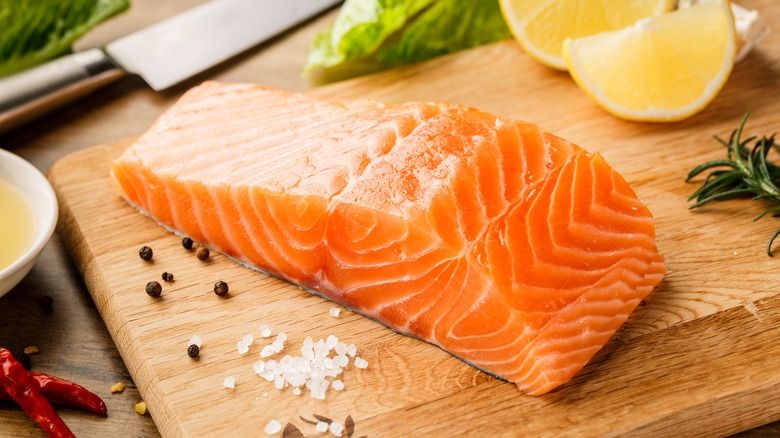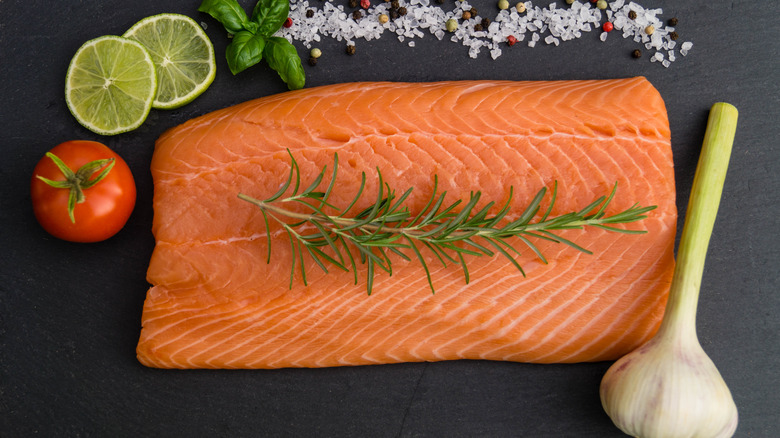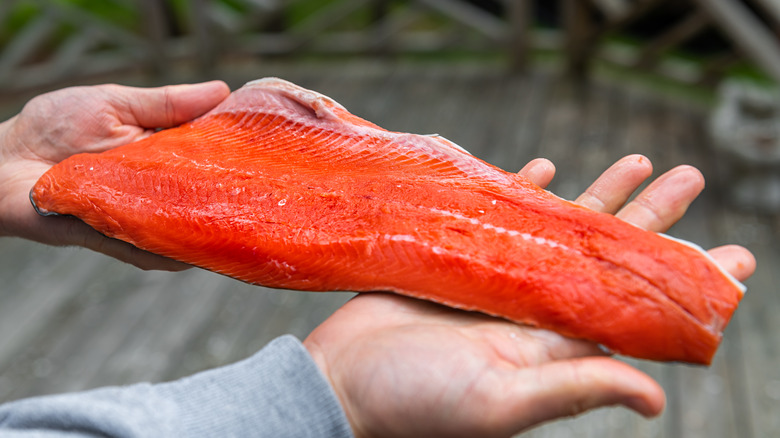The Biggest Mistake You're Making When Cooking Wild Salmon Vs Farmed
Salmon is one of the most popular fish eaten around the world. This is no surprise, as it's delicious, easy to prepare, and extremely versatile. Whether you're making a parmesan-crusted salmon, deconstructing your fish to make salmon croquettes with dill, or simply trying to figure out what to do with leftover salmon, there's no shortage of options at your disposal. And whether you're dealing with wild-caught or farm-raised salmon, it all cooks the same, right?
No, it definitely does not. Just as there are huge flavor and texture differences between different species of wild-caught salmon, similar differences exist between wild-caught and farm-raised, and that means you can't cook them exactly the same way. Ultimately, it comes down to one main difference: Wild-caught salmon tend to be leaner than farm-raised, meaning it'll overcook much more easily. As a result, you have to watch them carefully — and definitely pay attention to the recipes you're using, because most typically apply to farm-raised.
Farm-raised and wild caught salmon live very different lives
Though there are a bunch of types of wild-caught salmon and some are leaner than others, all of them are going to have less fat than farm-raised salmon. There's a pretty simple reason for this: Farm-raised salmon live in pens, which gives them a decidedly more sedentary lifestyle than their wild cousins. This results in higher fat content, as their muscles are underworked and the collagen in their flesh contains fewer cross-links, making their meat more tender. For purposes of cooking, this means you have more of a cushion before your salmon dries out.
Wild salmon, though, has to spend its life hunting for its food as a carnivore and thus moves around a lot. This means its muscles get a workout — to say nothing of the famous upriver swim salmon undergo to spawn. The end result is a far leaner cut of flesh that can dry out very quickly if you're not careful. In general, you want to cook wild-caught salmon to 120 degrees Fahrenheit and farm-raised to 125 degrees Fahrenheit.
If you're working from a recipe, you have to pay even closer attention. Farm-raised is the vast majority of salmon consumed around the world (around 70% of the total), and as a result, recipes are generally written for farm-raised unless otherwise specified.
There are more salmon-cooking mistakes than you might think
There are plenty of other cooking mistakes people might make with salmon, too. You always want to check for pin bones (which aren't actually bones, but calcified nerve endings) before you cook your fish by moving your fingers down the filet to feel for them on the surface. Meanwhile, leaving the fish in its marinade for longer than 20-30 minutes is a salmon marinating mistake to avoid at all costs, because any more than that will break down the meat and turn it into mush. And you never want to microwave leftover salmon; in addition to creating a horrible smell in the kitchen (or worse, at the office), microwaving fish will dry it out, turning it inedible. Instead, just eat it cold or use it to make something like croquettes.
As long as you follow these rules, your salmon experience will go smoothly and taste delicious. Just be sure to know whether you're working with wild or farm-raised salmon and treat it accordingly.


